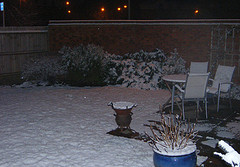
flickr.com/sparker
Usually, people draw up their landscaping plans while visions of gloriously clear days dance in their heads. But it’s a mistake for homeowners to invest all of their money and time into plants to tend on sunny summer afternoons, without considering that these same landscapes must endure inclement weather as well.
Depending on where you live, rain and snow will play a big part in your landscaping decisions. For this reason, it’s vital to take the time to learn about your climate, and whether the plants and materials you choose will survive from season to season. The library is a great resource for both landscaping books and environmental statistics. You can also search the Internet for gardening websites, or talk to the professionals at your local garden center about landscaping for the elements.
Freezing temperatures, snow accumulation and large amounts of rain will affect your landscaping. If your yard tends to get very muddy in winter or has puddles remaining after a heavy downpour, you’ve got some drainage issues to address. Creating proper drainage systems is certainly essential to the health of your landscape, so unless you’re a very experienced gardener, it’s best to call a professional.
It is likely to have your landscaping designed so that the rain will provide natural irrigation for your plants. This process has, in fact, a number of benefits. If you reside in an urban area, water from your garden hose will come directly from the city reserves. This water will have gone through a treatment method that involves a number of chemicals, including chlorine. As you can imagine, plants will survive on a diet of natural rainwater, as opposed to chemically treated tap water. You should also consider the money you’ll save by relying on rainwater for natural irrigation, instead of maxing out your city water bill. With proper planning, you can direct most of the rainwater that falls into your yard to feed the trees and the plants. There will be dry spells, of course, especially the hottest summer days, when you will need to provide some added irrigation. It’s important that you understand the local weather to plan and provide the best care for your plants.
Snow is also a very crucial element to the year-round health of your yard. Snow is just as vital to your landscaping project as rain is, as a layer of snow normally helps to keep the soil at a warmer temperature. This can stop tender plant roots from freezing and dying over the frigid winter months. Water from melting snow sinks into the ground and provides the energy boost needed to provide plants a jump-start in spring. As the snow starts to melt, your spring bulbs will blossom in perfect form, giving your well-planned landscaping an early splash of vibrant colour.
To help evaluate the landscaping needs of your property, make note of how rain is transferred across the yard. This is an essential step in planning your project, and it’s easy to do. Next time it rains, grab your umbrella and boots and take a stroll around your property. Make note of areas where puddles develop, and other places where drainage happens. Know what needs to be accomplished before you begin, and you’ll be on your way to a successful landscaping project.
Gardens aren’t simply for summertime; they need year-round care. As a matter of fact, taking the time to plan and create landscaping for the elements pays off in a gorgeous all-season garden you’ll be proud to display.
Tagged with: garden landscaping • gardening tips
Filed under: Landscaping
